- Get link
- X
- Other Apps
- Get link
- X
- Other Apps

What was common to the seven wonders of the world in antiquity? Most of these structures were included in the "short list", due to its scale, which caused trepidation among travelers and scientists. For example, the Colossus of Rhodes towered 33.5 meters above the Mediterranean Sea until an earthquake brought the bronze giant to its knees. The largest of the three pyramids of Giza - the pyramid of Cheops - four thousand years was the highest structure in the world.
Modern engineers continue to raise bids when it comes to building something big. We even wrote recently about how high a skyscraper can be built at all, and we found out that hoo. Just look at the Three Gorges dam, the monstrous hydroelectric station that stands on the Yangtze River in China, or on the Burj Khalifa, the tallest skyscraper in the world, crowning Dubai.
Others try to just shock the public. Avant-garde designers and architects create surrealistic structures that evoke nothing but a strange feeling of easy madness. The final products do not seem giant, but the stunning imagination of bends, defying the force of gravity, also cause exclamations "hey-whoo-whoa."
Together with the Discovery subsidiary, we selected ten wonders of modern architecture and engineering embodiments for you. Let's start with the tower, which became great-great-grandson of the Leaning Tower of Pisa.
Capital gate
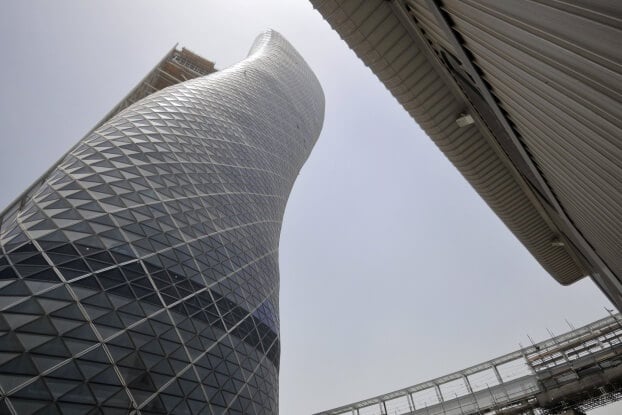
Most engineers do not want their skyscrapers to lean. On the contrary, the building, which begins to bend immediately after construction, almost always points to the shoals in the project. The Leaning Tower of Pisa, for example, was built on weak, unstable soil, with the result that it tilted to one side. The angle of inclination is four degrees relative to the center.
Say “hello” to the crazy engineers who decided to build the same building curves. Here, for example, Capital Gate, a 35-story skyscraper located on the island of Abu Dhabi, UAE. In accordance with the project, the structure is inclined by 18 degrees - which is more than four times the “leaning” lean. To embody their design, the engineers hammered 490 piles 30 meters long into the soil and built a strong foundation from a dense mesh of reinforcing steel. Then a “pre-curved core” was erected - a reinforced concrete spine with signs of scoliosis. Well, since the core is crooked, the whole building is crooked too. Workers had to cut diamond-shaped panels, because each of them was at a unique angle.
In 2010, the Guinness Book of Records designated Capital Gate as the “Farthest Man-made Leaning Building”, which can be translated literally as “the most leaning tower created by human hands”. The only thing: unlike the Leaning Tower of Pisa, this building has a usable area that houses exclusive offices and the five-star Hyatt Hotel.
Laerdal Tunnel
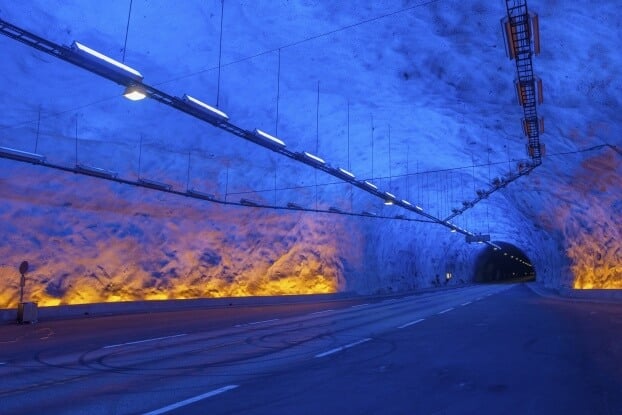
To connect the Norwegian cities of Laerdal and Aurland by the road, the engineers had to solve a small problem: Hornsnip and Yeronnosi mountains. Instead of trying to go around the mountains, the engineers decided to drill through them. The result is the Laerdal Tunnel (Laerdal Tunnel), which passes through a solid gneiss rock for 24 kilometers and deservedly bears the title of the longest road tunnel in the world.
To drill such a structure is not the biggest problem. Designers also had to make sure that motorists would be able to make such a long underground crossing without undergoing “road hypnosis”. To solve this problem, the Norwegian public roads administration took on a team of psychologists who were supposed to revitalize the road as much as possible. It was recommended to turn on blue lights and neat curves to occupy the drivers. It was also decided that the tunnel would be divided into four sections, which would help to dilute the monotony. Twenty-four kilometers under the arch of the rock in a straight line, this is not a fucking mukhra, you can “stick” here, sorry for common language.
Motorists entering the Laerdal tunnel today may not notice these design improvements, but they certainly appreciate them when they safely leave on the other side after a 20-minute drive through the center of the mountain.
Die gläserne manufaktur
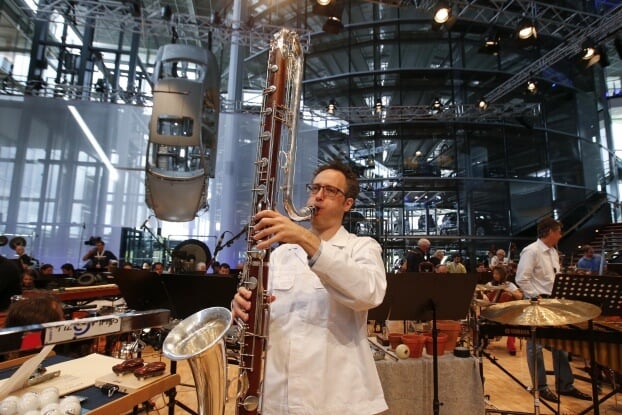
When most people think of a factory, they see a huge box hung with chimneys. In 2001, Volkswagen redefined the automotive industry and built Die Gläserne Manufaktur, the “glass factory,” to build the luxury Phaeton sedan. The building is located right in the center of German Dresden, challenging the city planners, who said that manufacturing cannot exist side by side with urban culture and life.
On the other hand, the “glass factory” is not such an ordinary production hall. You will not find chimneys, epoch-making noise, or toxic waste. The walls of the factory contain 26,942 square meters of glass, which means people can observe what is happening inside there. Without a doubt, they drool at the Canadian maple floors, or wonder why the front lobby looks like an opera house. But when you catch a glimpse of different parts of Phaeton, conveyor belts and robots waiting to be assembled with 227 workers, there is no doubt that this is a car factory.
Perhaps this will look like all the factories of the future.
Kansas City Central Library Parking
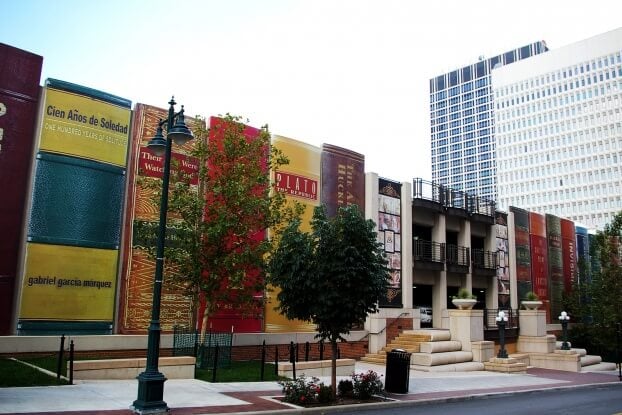
If you tried to read “Kill a Mockingbird” on a bookshelf behind the Kansas City Central Library, you would both be disappointed and delighted. First, the spine of the book is 7.6 meters by 2.7 meters. Secondly, this book is not hidden behind the oversized root. Together with 21 other "masterpieces of literature", it forms a false shelter for the library garage. The building designers decided not to hide the garage behind the main building, and the usual concrete box didn’t fit them either. Parking earned in 2004.
The project team also carefully considered public opinion. Kansas City residents suggested which books to leave on the main bookshelf, so librarians narrowed the list to 22 pieces of fiction and nonfiction literature and poetry, including a two-volume Kansas City history book. Along with Harper Lee's masterpiece, you will find Joseph Heller's Trick-22, Ray Bredberry's 451 degrees Fahrenheit, Ralph Elson's Invisible Man, The Tale of Two Cities by Charles Dickens, and The Silent Spring, by Charles Dickens, and Charlotte's Web ”by E. B. White. Now they are all giants of literature naturally.
Zenith giant telescope
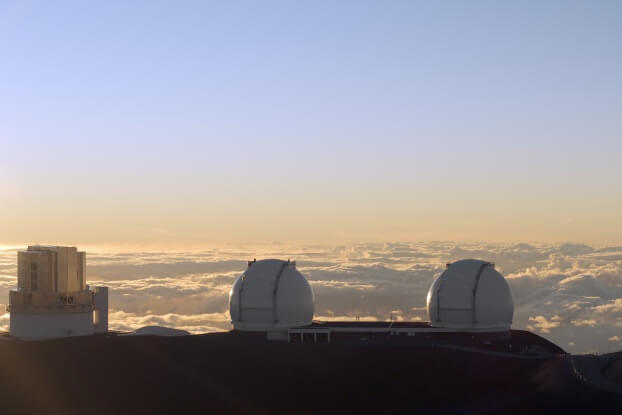
Optical telescopes, which should turn our view of the stars, nebulae and exoplanets, require the same engineering skills as dams, tunnels and bridges. For example, the main mirror of the Subaru telescope, which is located on the Mauna Kea plateau in Hawaii, is 8.2 meters in diameter and weighs more than 25 tons. A structure that supports the optics and the surrounding system will bypass any competitive building in complexity.
One of the biggest problems with traditional telescopes is the delivery of the mirror to the top of the mountain without damage. After this, astronomers must constantly tune the system to account for the deformation caused by gravity, humidity and other environmental conditions. Liquid-mirror telescopes, like the Large Zenith Telescope at the University of British Columbia, solve this problem. LZT uses liquid mercury in the main mirror, since it can be poured in place and maintain an ideal parabolic shape as the telescope rotates at a constant speed. Such a telescope reflects 75% of the incoming light of stars and costs five times less than an optical telescope.
Today, LZT holds the record as the world's largest mercury telescope, but India, Belgium and Canada have teamed up to create an even larger model - the International Liquid-Mirror Telescope, which will operate at the peak of Devasthal in northern India.
Palm jumeirah
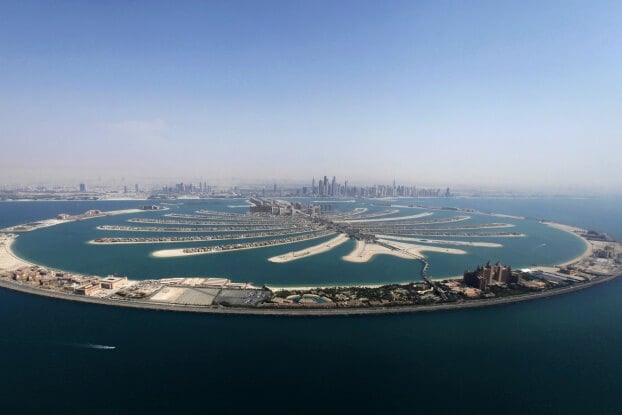
Over the past ten years, the city of Dubai has experienced phenomenal growth, concentrating for the most part 60 kilometers from the coast bordering the Persian Gulf. Unfortunately, all high-rise apartments, skyscrapers and hotels stand shoulder to shoulder on the shore, leaving no room for development. To solve this small problem, Nakheel Properties, a government-backed company, decided to extend the coastline of Dubai with three artificial land mass called Palm Islands.
How would you accomplish such a feat? Would tons of sand and stone be poured until an artificial island formed in the ocean? Workers dragged over 3 billion cubic meters of sand to create the Palm Jumeirah, the first of three islands. But they didn’t just dump the material into the mound. They created an archipelago in the shape of a palm tree with a trunk of 2 kilometers and a crown of 16 leaves surrounded by a crescent. The GPS data helped them understand that the structure maintained its symmetry during the entire construction period.
In 2013, Palm Jumeirah remains the largest artificial island in the world - at least until its companions have not yet grown out of the sea. Upon completion of construction, Palm Deira will be even more, having won about 47 square kilometers from the Persian Gulf.
Melbourne Rectangular Stadium (AAMI Park)
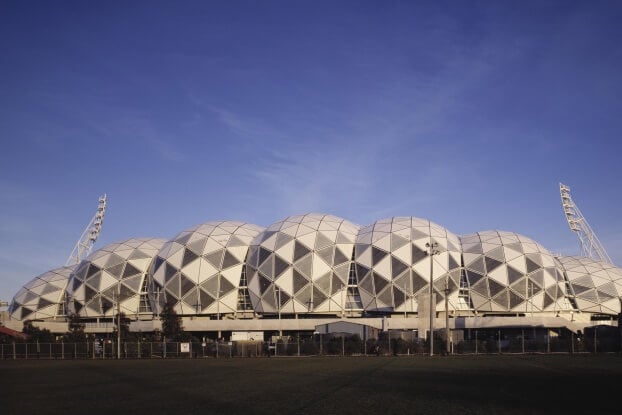
The name suggests that we have a completely boring structure. What can be interesting in a rectangular stadium? However, if you look from a bird's eye view of AAMI Park, as it is called in Australia, you will understand why the project was designated as “a new generation of sports stadiums”. The main distinguishing feature is the roof, which draws inspiration from the geodesic domes of the American engineer R. Buckminster Fuller. To build a geodesic system, you put together the polygons that make up a sphere. As a result, the structure becomes durable, but uses far less materials than traditional construction methods.
The roof of the AAMI Park contains several geodesic domes, packed together like a bubble with a complex surface. At the same time, the stadium uses 50% less steel than the usual cantilever construction. It also contains significant amounts of recycled building material, collects rainwater from the roof and minimizes energy consumption. At the opening in May 2010, the stadium collected a number of awards in the field of architectural innovation, engineering and ecology. But environmentalists were not particularly happy - after all, 30,000 spectators can make a lot of noise.
Ericsson globe
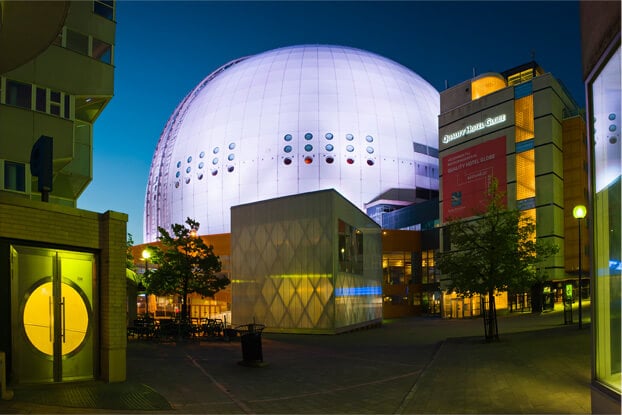
The Ericsson Globe (Ericsson Globe), a sports arena in Stockholm, also won a number of awards. 110 meters in diameter, 85 meters high and 600,000 cubic meters in volume, it is the largest spherical structure in the world. And what is most surprising, not much time was spent on its construction. Workers began to dig the ground on September 10, 1986, and the building opened on February 19, 1989. The entire construction process took only 2.5 years.
The size of the Ericsson Globe makes it ideal not only for hockey and entertainment. He also plays an important role in the world's largest educational model. Yes, you heard right. The department of astronomy at the University of Stockholm decided to depict the correct scale of our planetary system using structures scattered throughout the Swedish countryside. The globe serves as an analogue of the Sun, setting the scale of the model, which should be in the proportion of 1: 20,000,000. All the inner planets are within the city limits of Stockholm, but the outer ones go far to the north. For example, Neptune is located in Soderhamn, 246 kilometers from Globus, and Pluto is in Delsbo, generally 300 kilometers. Each model has a reception facility, so tourists can travel to the planets without being lost in space.
China Central Television Headquarters
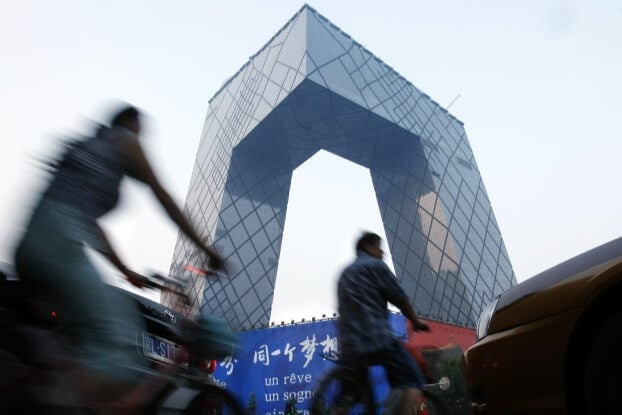
At first glance, the headquarters of China Central Television (CCTV) looks like something from the category of Escher's painting. But this is not a fantastic image of endless stairs and loops. The building opened in 2012, after 10 years of design, development, and near-disaster. The fire in the building next to the CCTV almost got the project off the rails. Today, an entertaining structure can be seen from anywhere in Beijing.
Rolling bridge

As we have already noted, building more is not the only way for engineers to make an impression. Rolling Bridge, which allows pedestrians to walk along the London Grand Union Canal, is only 11.8 meters in length. But its innovative design more than fills up its small size. The bridge consists of eight sections of wood and steel fastened together and being completely elongated lies flat. Then, under the action of hydraulic pistons, the sections can stretch out and curl into themselves. While the boats quietly pass through the canal, the bridge is on the shore like a small sculpture.
Rolling Bridge is the brainchild of Thomas Hezerwick, who developed other architectural absurdities. For example, a giant cauldron that burned at the opening ceremony of the London 2012 Olympic Games and a star-forming sculpture. In 2008, Manchester asked Hezervik to demolish "B of the Bang". But here Rolling Bridge fell in love with everyone. And even received an award in 2005.
The article is based on materials .
- Get link
- X
- Other Apps
Comments
Post a Comment